Simple Summary
Castro et al. divided the genus Tenuipalpus into two groups, i.e., Tenuipalpus sensu stricto and Tenuipalpus sensu lato. Four new species groups of the Tenuipalpus sensu lato group are proposed in this study, considering the total number of dorsal opisthosomal setae. Additionally, diagnostic keys to new species groups and the world species of Tenuipalpus sensu lato are developed.
Abstract
Four new species groups of the Tenuipalpus sensu lato group are proposed in the present study based on the total number of dorsal opisthosomal setae, namely, carolinensis with ten pairs of setae (214 species), dubinini with nine pairs of setae (33 species), granati with eight pairs of setae (29 species), and barticanus with seven pairs of setae (7 species) Additionally, diagnostic keys to species groups and 273 species of the Tenuipalpus sensu lato are provided. Three species, T. lustrabilis Chaudhri, T. guptai Sadana and Gupta, and T. solanensis Sadana and Gupta, are synonymized with T. punicae Pritchard and Baker. One species, T. rodionovi Chalilova, is suggested as a junior synonym of T. granati Sayed, and eight species, T. chiococcae De Leon, T. costarricensis Salas and Ochoa, T. ephedrae Livschitz and Mitrofanov, T. molinai Evans, T. santae Manson, T. simplychus Cromroy, T. tetrazygiae De Leon, and T. oxalis (Flechtmann), belonging to the carolinensis species group, are not included in the key. Furthermore, a new species of Tenuipalpus sensu lato, T. jazanensis sp. nov., is described and illustrated based on females collected from the Chamaerops spp. (Arecaceae).
1. Introduction
Tenuipalpus Donnadieu is the largest genus in the family Tenuipalpidae Berlese (Acari: Prostigmata: Tetranychoidea) and consists of more than 320 species, distributed worldwide, especially in the tropical and subtropical regions [1,2,3]. The members of this genus are mostly oligophagous in their feeding habits [2]. The three species, i.e., T. granati Sayed, T. punicae Pritchard and Baker, and T. eriophyoides Baker, are serious pests of fruit trees worldwide [4].
The genus Tenuipalpus was erected by Donnadieu in 1875 [5]. Based on the number of dorsal setae and palp segmentation, Reck [6] and Mitrofanov [7] erected six genera by transferring some of Tenuipalpus species, Extenuipalpus Reck [6], Aegyptopalpus Mitrofanov [7], Deleonipalpus Mitrofanov [7], Gnathopalpus Mitrofanov [6], Tuttlepalpus Mitrofanov [7], and Ultratenuipalpus Mitrofanov [7]. Meyer [8] synonymized five of those genera with the genus Tenuipalpus by using the same morphological characters and proposed six species groups, namely, albae, caudatus, elegans, granati, quadrisetosus, and trisetosus. Later, Baker and Tuttle [9] recognized only two species groups, caudatus and proteae, based on the presence and absence of setae f2 (seven and six pairs of dorsolateral setae), respectively. Further, they divided the caudatus group into three species subgroups based on the number of intercoxal setae (3a and 4a). Meyer [10] followed the concept of Baker and Tuttle [9] and divided the proteae into three species subgroups and added two more species subgroups to the caudatus group.
Collyer [11] made the world key of 102 Tenuipalpus species. Additionally, some local keys were developed over time by Meyer [10], which included around 90 species from Africa; Baker and Tuttle [9] included 20 species from Mexico; Al-Gboory [12] included seven species from Iraq; Khanjani et al. [13] included nine species from Iran; Castro and Feres [14] included 12 species from Brazil; and Xu et al. [15] included 25 species from China.
For more than three decades, Tenuipalpus species groups, as proposed by Baker and Tuttle [9] and Meyer [10], were consistent. However, recently, Castro et al. [1] divided the genus into two groups by using a combination of characters: Tenuipalpus sensu stricto (36 species), with a pair of lateral projections associated with setae c3 and only one pair of setae 4a, and Tenuipalpus sensu lato (287 species), without a lateral projection associated with setae c3 and one to four pairs of setae 4a. Also, a world key to the species of Tenuipalpus sensu stricto was provided [1,16]. However, no diagnostic key to the world species of Tenuipalpus sensu lato has been developed yet.
The aims of the present study were to (i) classify all species of Tenuipalpus sensu lato into new species groups based on distinct morphological characters; (ii) develop diagnostic keys to species groups and 273 species of the Tenuipalpus sensu lato; and (iii) examine specimens of Tenuipalpus species collected from different regions of Saudi Arabia.
2. Materials and Methods
The published taxonomic literature of all known 287 species belonging to the Tenuipalpus sensu lato group was collected using different resources: the Acarology Laboratory King Saud University, Google Scholar, ResearchGate, and different acarological journals, and through personal communication (Dr. Qing Hai Fan, Fujian Agriculture and Forestry University, China; and Dr. Elizeu B. Castro, São Paulo State University, São José do Rio Preto campus, São Paulo, Brazil). Diagnostic keys to species groups and 273 species are provided. All specimens of the genus that were collected by the Acarology lab have been examined. The mounted specimens of Tenuipalpus species were examined and identified under a phase contrast microscope (DM2500, Leica, Wetzlar, Germany). Different mite body parts were pictured using an Auto-Montage software system v4.0.1.1 (Syncroscopy, Cambridge, UK) and drawn with Adobe Illustrator v27.7 (Adobe System Inc., San Jose, CA, USA). All measurements are in micrometers. The terminology used in the research follows that of Mesa et al. [2]. The specimens were deposited at the King Saud University Museum of Arthropods (KSMA, Acarology Section), Department of Plant Protection, College of Food and Agriculture Sciences, King Saud University, Riyadh, Saudi Arabia.
3. Results
The Tenuipalpus sensu lato group was divided into four species groups based on the total number of dorsal opisthosomal setae, namely, the carolinensis group—with ten pairs of setae (214 species), the dubinini group—with nine pairs of setae (33 species), the granati group—with eight pairs of setae (29 species), and the barticanus group—with seven pairs of setae (seven species). This proposed division did not consider whether a specific setae was absent or not (i.e., any setae among the opisthosomal setae can be absent). The diagnostic keys to those four new species groups and 273 species of Tenuipalpus sensu lato were also developed.
Among the carolinensis group, eight species were not included in the key: T. chiococcae De Leon, T. costarricensis Salas and Ochoa, T. ephedrae Livschitz and Mitrofanov, T. molinai Evans, T. santae Manson, T. simplychus Cromroy, T. tetrazygiae De Leon, and T. oxalis (Flechtmann) (Table 1). Three species; T. guptai Sadana and Gupta, T. solanensis Sadana and Gupta, and T. lustrabilis Chaudhri, were synonymized with T. punicae Pritchard and Baker. Two species, T. simplex Vitzthum and T. jasmini Khan were poorly described; they were tentatively placed in the new groups of carolinensis and granati, respectively. The species T. rodionovi Chalilova was suggested as a junior synonymy of T. granati Sayed.

Table 1.
List of species not included in the diagnostic key of the new species group carolinensis.
Among the examined Tenuipalpus specimens collected from different regions of Saudi Arabia, a new species, Tenuipalpus jazanensis sp. nov., belonging to the Tenuipalpus sensu lato group, resulted. The new species is hereby fully described and illustrated based on females collected from the European fan palm, Chamaerops spp. (Arecaceae) from the Jazan region (Figure 1, Figure 2, Figure 3 and Figure 4).
3.1. Family Tenuipalpidae Berlese, 1913 [25]
Genus Tenuipalpus Donnadieu, 1875 [5].
Type species:Tenuipalpus palmatus Donnadieu, 1875 [5] (=Tenuipalpus caudatus Dugès, 1834) [26].
Diagnosis: (modified after Castro et al. [16]): Prodorsum have three pairs of setae (v2, sc1, sc2) except the species T. elegans (Collyer) with two pairs of prodorsum setae (sc1, sc2), setae v2 absent, opisthosoma with 7–10 pairs of setae; (c3, d3, e3, f3, h1, h2 present; c2, d2, e2 absent; c1, d1, e1, f2 present or absent (d1, e1 rarely absent), setae h2 elongate, flagellate; palp one- to three-segmented; venter with one to two pairs of setae 3a (3a1 always present; 3a2 present or absent) and one to five pairs of setae 4a (4a1 always present; 4a2, 4a3, 4a4, 4a5 present or absent); two pairs of pseudanal setae ps1-2 (three pairs, ps1-3, rarely present).
3.2. Divisions of the Tenuipalpus Sensu Lato Group
Tenuipalpus sensu lato Castro et al. [1]
Diagnosis: (modified after Castro et al. [1]). Opisthosoma without one pair of lateral body projections associated with setae c3, venter with one to five pairs of intercoxal setae 4a.
3.2.1. T. carolinensis Species Group
Diagnosis: (based on female). Opisthosoma with ten pairs of dorsal setae. This group consists of 214 species.
3.2.2. T. dubinini Species Group
Diagnosis: (based on female). Opisthosoma with nine pairs of dorsal setae. This group consists of 33 species.
3.2.3. T. granati Species Group
Diagnosis: (based on female). Opisthosoma with eight pairs of dorsal setae. This group consists of 29 species.
3.2.4. T. barticanus Species Group
Diagnosis: (based on female). Opisthosoma with seven pairs of dorsal setae. This group consists of seven species.
3.3. New Species
Tenuipalpus (sensu lato Castro et al. [1])
T. carolinensis group
Tenuipalpus jazanensis sp. nov.
urn:lsid:zoobank.org:act:ACDFDCC0-A7D3-4B3B-8618-27E9F14A6A44
Diagnosis: (based on Female). Propodosoma without lateral lobes anterior marginally; propodosoma with transverse striate medially and laterally, reticulated sublaterally. Hysterosoma medially with few reticulations in the area between setae c1-c1 and sublaterally; one pair of seta 3a and five pairs of setae 4a (4a1−5) present; rostrum reaching to the middle of femur I; palp three-segmented; legs setal counts on coxae, 2–2–1–1 trochanters, 1–1–2–1; femora 4–4–2–0; genua 3–2–1–1; tibiae 5–5–3–3 and tarsus 8 (1)–8 (1)–5–5.
Description Female (n = 5)
Dorsum (Figure 1): Anterior margin of prodorsum deeply incised, depth of notch 25 (24–27), propodosoma without lateral lobes anterior marginally; propodosoma with transverse striate medially and laterally, reticulated sublaterally. Hysterosoma medially with few reticulations in the area between setae c1 and sublaterally; dorsal body setae lanceolate serrate, almost equal in length, except setae h2; opisthosomal pores present; distance between setae v2–h1 339 (335–355), sc2–sc2 180 (160–240). Prodorsum slightly wider than proximal section of opisthosoma; anterior central of prodorsum with transverse striations; lateral regions with reticulations. All dorsal setae short (except h2), not more than 23 μm long; setae v2, sc1, and sc2 serrate, sc2 longer than v2 and subequal in length with sc1; opisthonotum with reticulations; opisthosomal setae serrate; setae e3 shorter than f2 and f3, h2 flagelliform and elongate serrate. Setal lengths: v2 16 (13–16), sc1 23 (20–23), sc2 23 (19–23), c1 13 (13–16), c3 13 (12–15), d1 12 (12–13), d3 14 (12–16), e1 13 (10–15), e3 12 (12–15), f2 14 (14–16), f3 14 (14–16), h1 14 (14–20), h2 233 (230–239). Distance between dorsal setae: v2–v2 43 (41–43), sc1–sc1 107 (95–107), c1–c1 57 (52–59), c3–c3 195 (192–197), d1–d1 32 (30–39), d3–d3 156 (160–169), e1–e1 25 (12–25), e3–e3 82 (82–90), f2–f2 71 (66–72), f3–f3 56 (52–57), h2–h2 41 (36–43), h1–h1 20 (20–23), c1–d1 45 (40–45), d1–e1 60 (60–62), c1–c3 66 (66–69), d1–d3 64 (59–65) e1–e3 41 (40–44), c3–d3 38 (30–38), d3–e3 121 (120–127), e3–f3 30 (28–36), f3–f2 10 (12–15), h1–h2 7 (7–10).
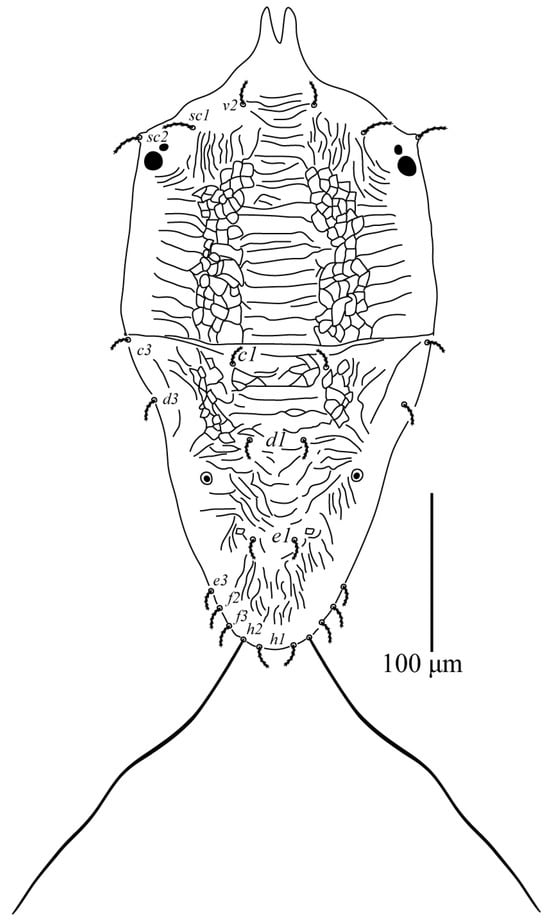
Figure 1.
Tenuipalpus jazanensis sp.nov. Female. Dorsum. Scale bar: 100 µm.
Venter (Figure 2): Ventral cuticle with broken longitudinal striations. Area posterior setae 4a with broken transverse striate. All ventral setae smooth, setae 1a, 4a flagelliform, and elongate. Setal lengths: 1a 82 (82–92), 1b 30 (22–31), 1c 30 (26–30), 2b 33 (23–33), 2c 33 (23–33), 3a 25 (25–31), 3b 30 (21–31), 4a1 90 (90–100), 4a2 83 (82–91), 4a3 83 (80–86), 4a4 76 (76–84), 4a5 73 (73–102), 4b 33 (30–33), ag 36 (26–36), g1 33 (26–34), g2 33 (25–33), ps1 23 (18–25), ps2 23 (18–23). Distance between ventral setae: 1a–1a 23 (19–24), 3a–3a 30 (30–32), 4a1–4a1 7 (5–7), 4a2–4a2 21 (19–22), 4a3–4a3 35 (31–36), 4a4–4a4 49 (42–49), 4a5–4a5 60 (57–62), 1a–3a 108 (102–110), 3a–4a1 57 (57–60), 1b–1c 14 (13–19), 2b–2c 20 (19–25).
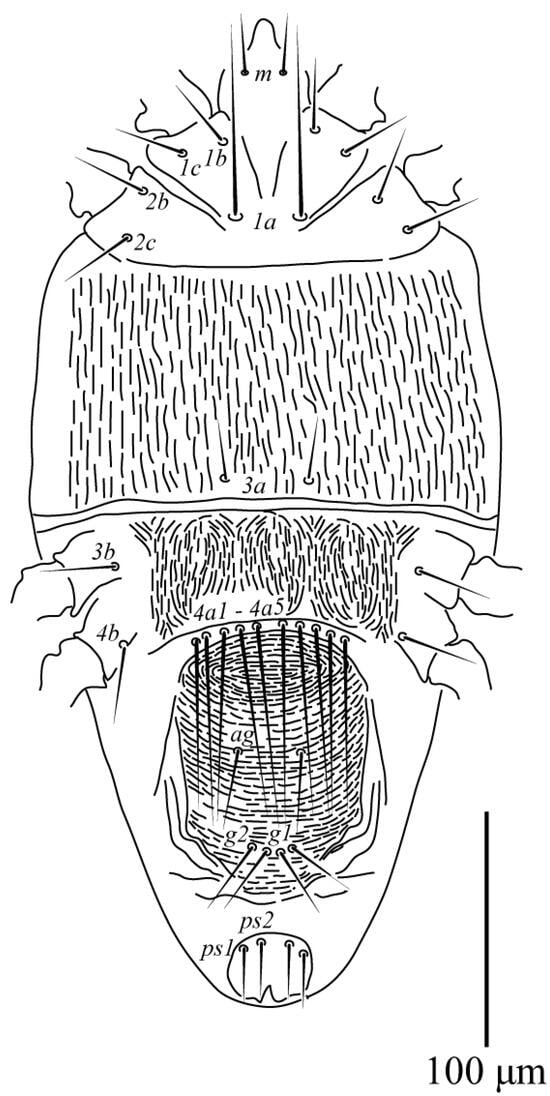
Figure 2.
Tenuipalpus jazanensis sp. nov. Female. Venter. Scale bar: 100 µm.
Gnathosoma (Figure 3): Ventral setae m 25 (14–25); distance between setae m–m 15 (10–15) Palps 3-segmented (Figure 3), median segment elongates, bearing one barbed seta d 15 (12–20); distal segment short, with eupathidium ul′ 4 (4–7) ul″ 15 (12–15).
Legs (Figure 4): Setae on legs as follows: coxa 2–2–1–1; trochanters 1–1–2–1; femora 4–4–2–0; genu 3–2–1–1; tibiae 5–5–3–3; tarsus 8 (1ω)–8 (1ω)–5–5; femur IV without seta. Leg I–IV setal count as follows (solenidia in parenthesis).
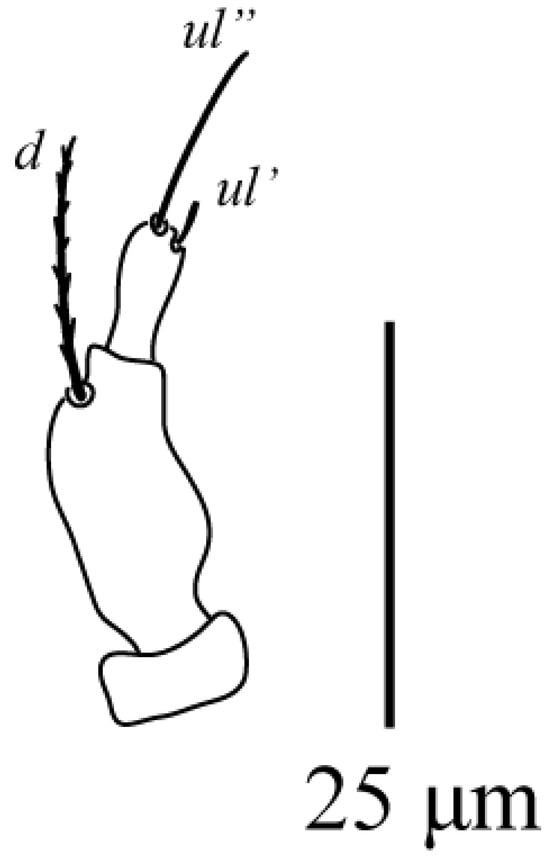
Figure 3.
Tenuipalpus jazanensis sp. nov. Female. Palp. Scale bar: 25 µm.
Males and immature. Unknown
Type Materials. Holotype female, four paratype females, from Chamaerops sp. (Arecaceae) Wadi Baydh, Jazan, 17°37.559’ N, 42°22.196’ E, 10 October 2020, coll. J. H. Mirza, H.M.S. Mushtaq and E.M. Khan.
Etymology: The specific epithet (jazanensis) is derived from the type region, Jazan.
Remarks: The new species, Tenuipalpus jazanensis sp. nov., belongs to the carolinensis species group. This species group is distinguished from other species groups of Tenuipalpus sensu lato by having ten pairs of opisthosomal setae. Tenuipalpus jazanensis sp. nov resembles T. pareriophyoides Meyer and Gerson and T. eriophyoides Baker by having more than three pairs of intercoxal setae 4a, one pair of setae 3a, dorsal setae lanceolate serrate and dorsum with irregular striate laterally. The new species differs from T. pareriophyoides and T. eriophyoides by the following characters; prodorsum medially with transverse striations; area in between setae c1, d1 and d3 with few reticulations (prodorsum medial area mostly smooth or punctate; area in between setae c1, d1 and d3 with rugose patten or striate); genu I with three setae (genu I with two setae); setae g and ag smooth (setae g and ag serrate in T. pareriophyoides; setae g and ag serrate in T. eriophyoides).
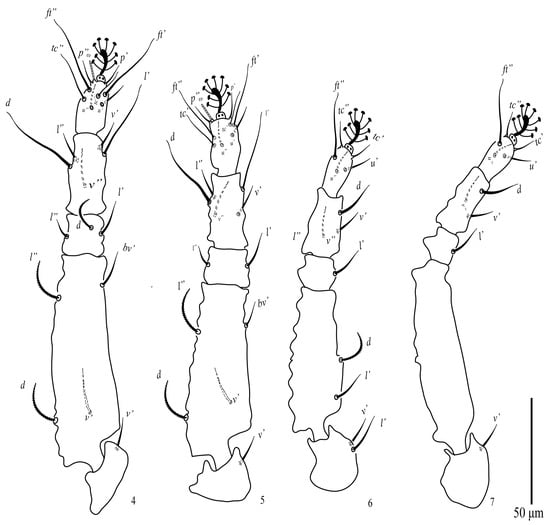
Figure 4.
Tenuipalpus jazanensis sp. nov. Female. 4, Leg I; 5, leg II; 6, leg III; 7, leg IV. Scale bar: 50 µm.
3.4. Key to the Groups and Species Groups of Tenuipalpus (Based on Females)
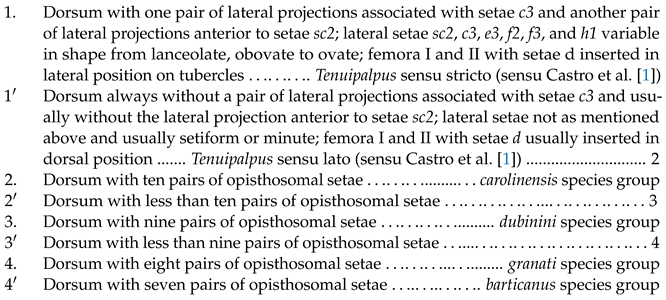
3.5. Key to the World Species of the T. carolinensis Species Group (Based on Females)

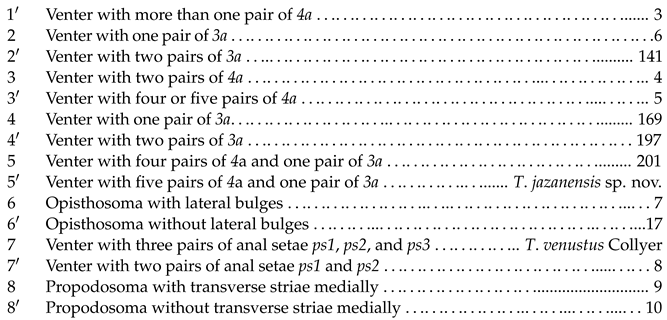
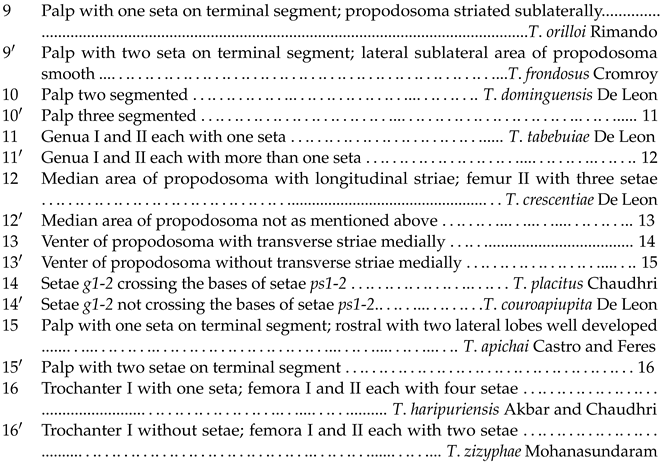
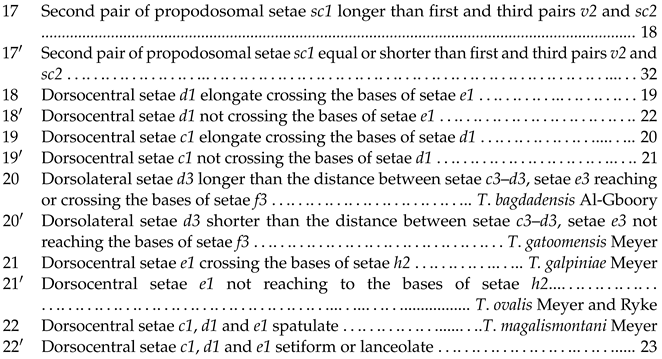
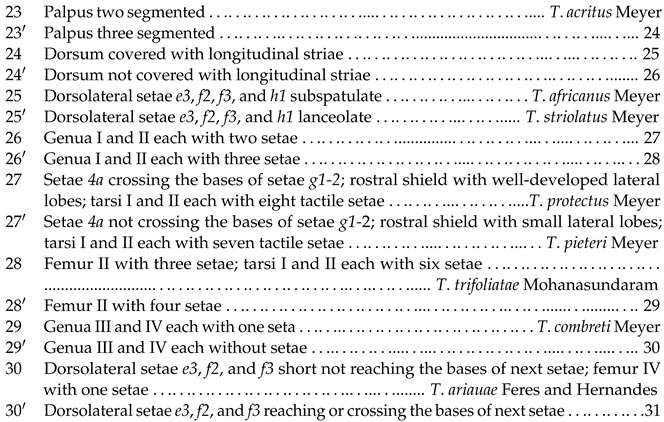
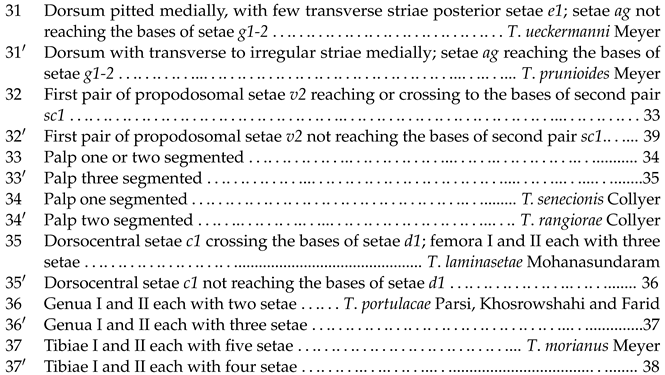
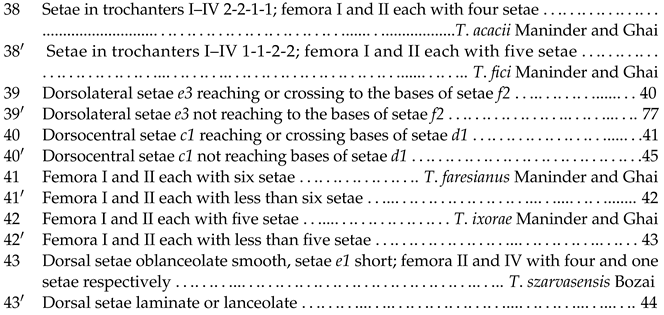

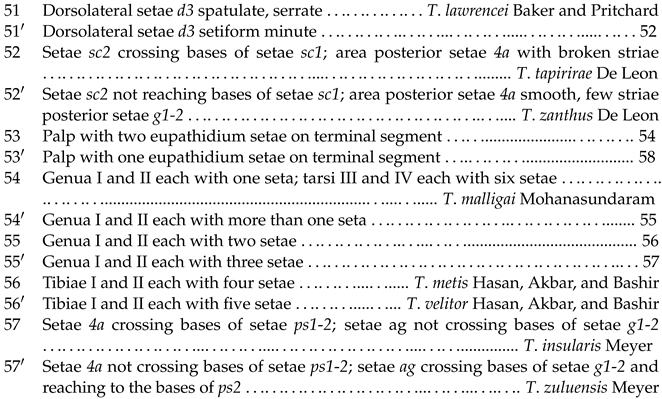


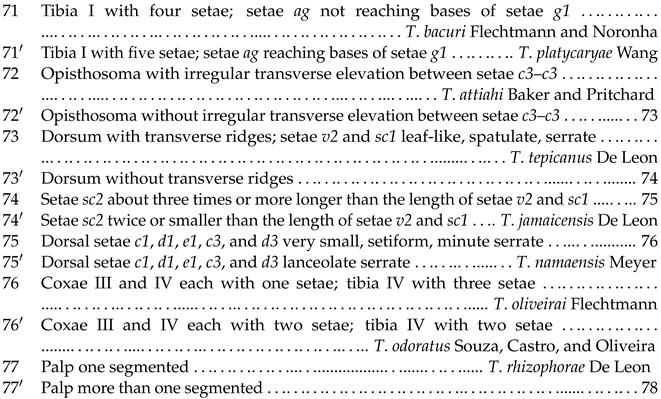
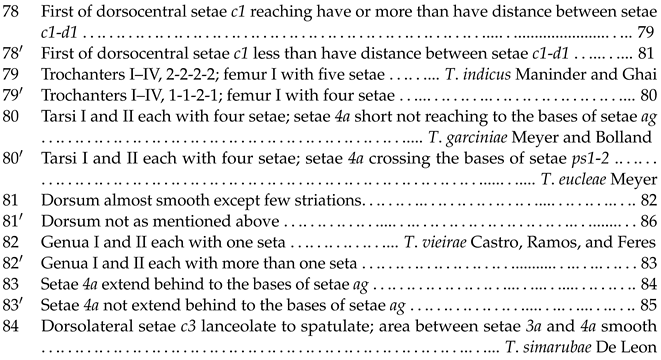
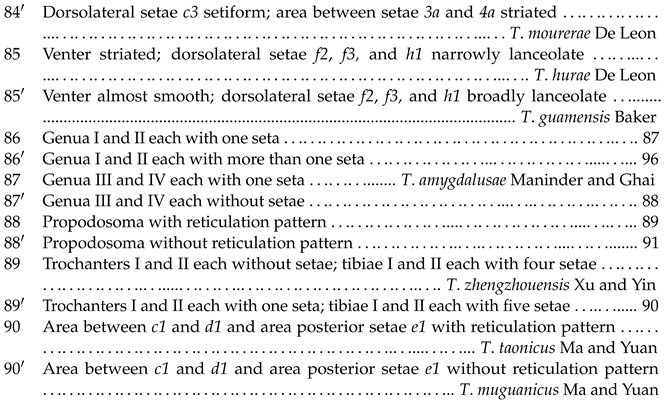
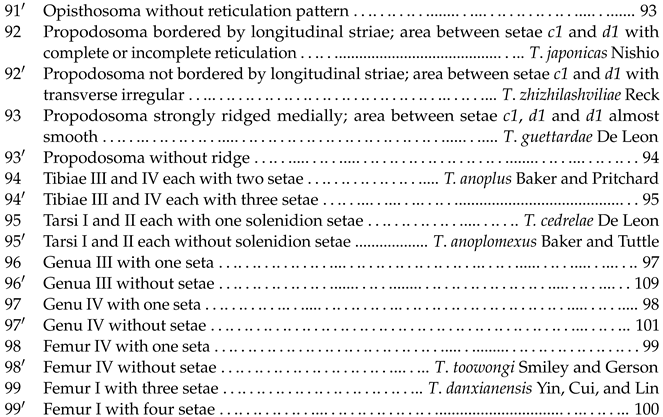

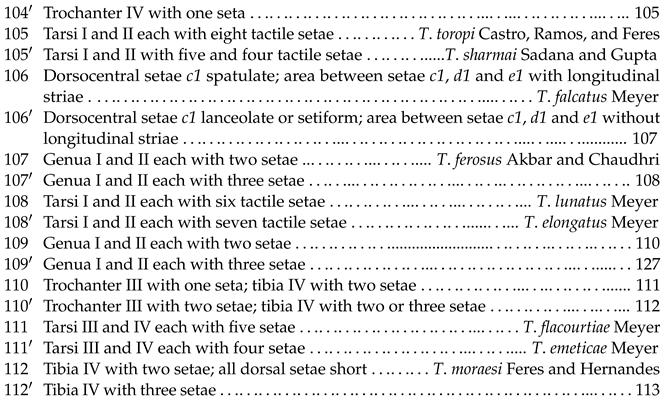
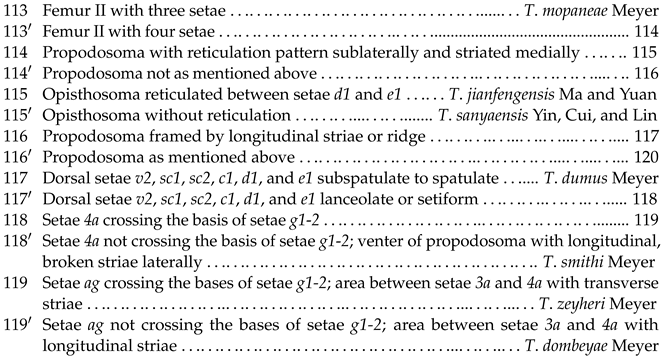
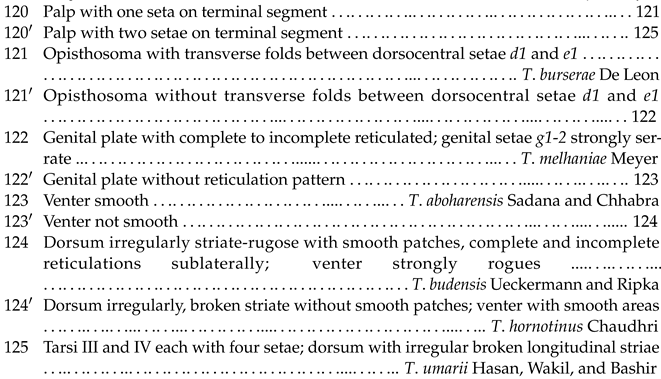
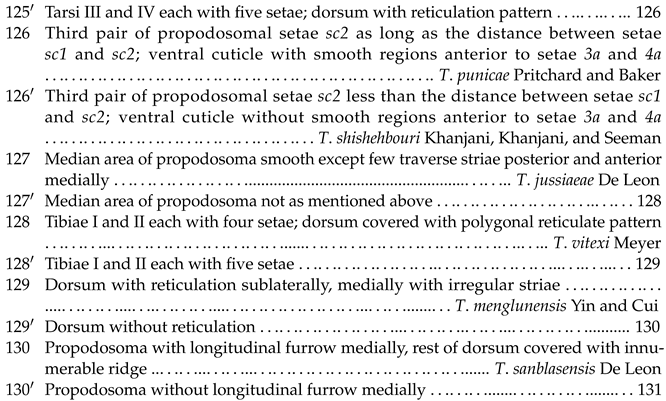
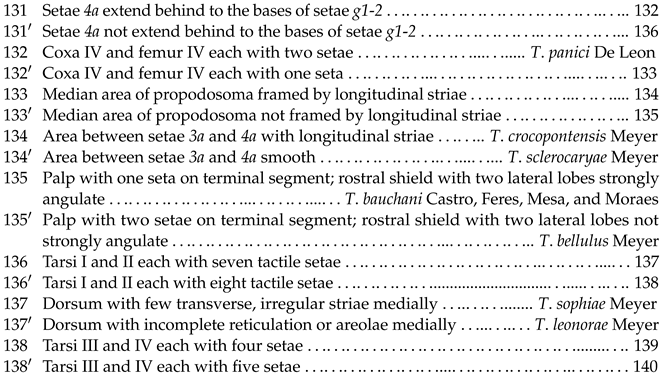
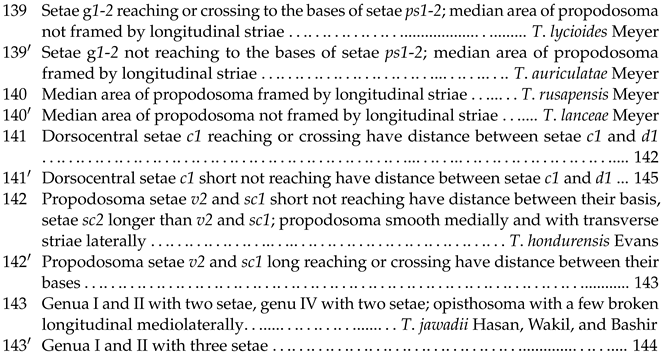
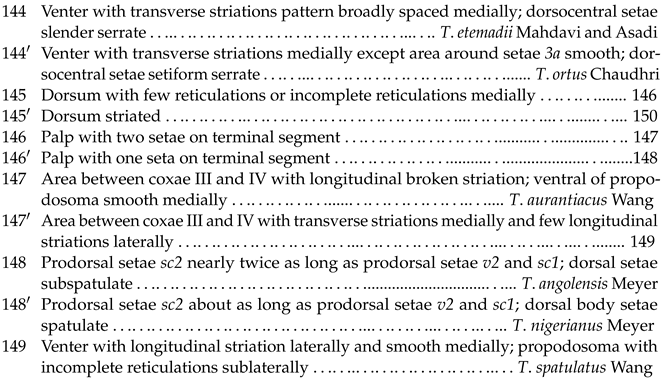
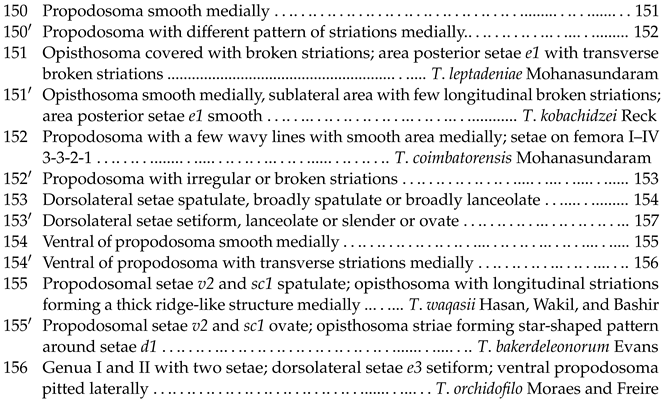
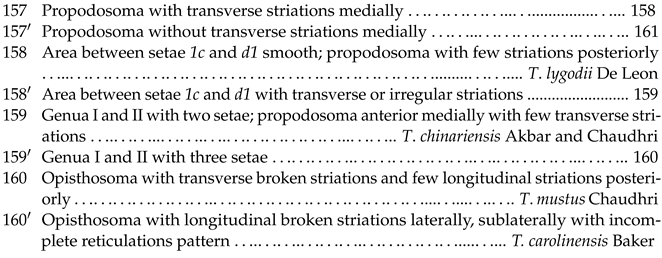
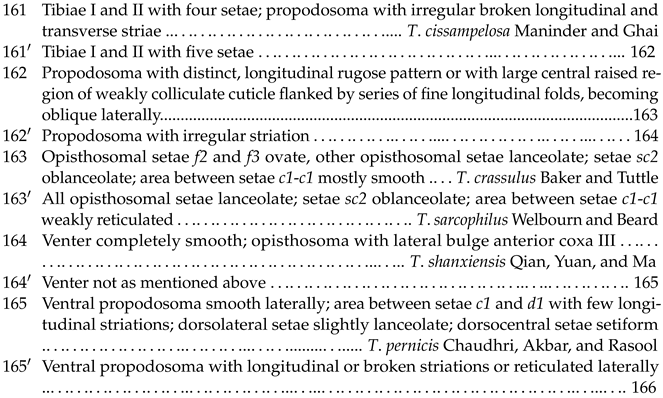
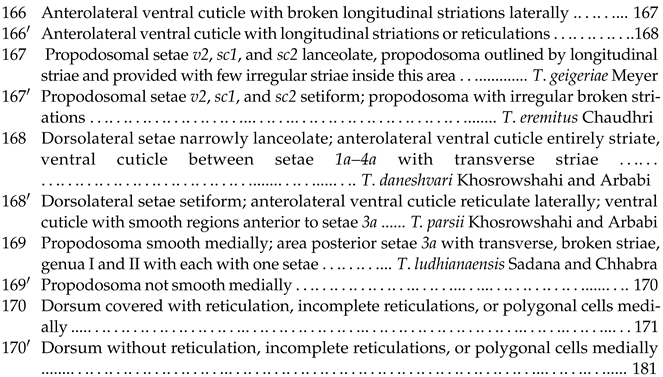
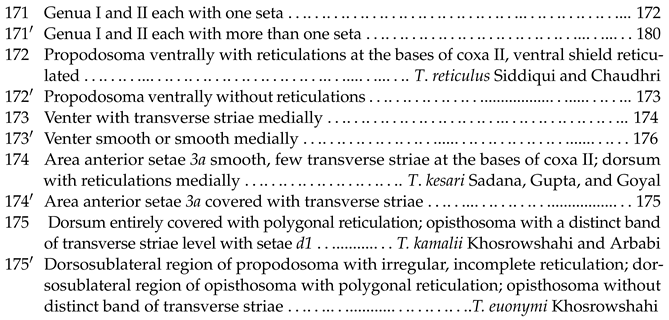
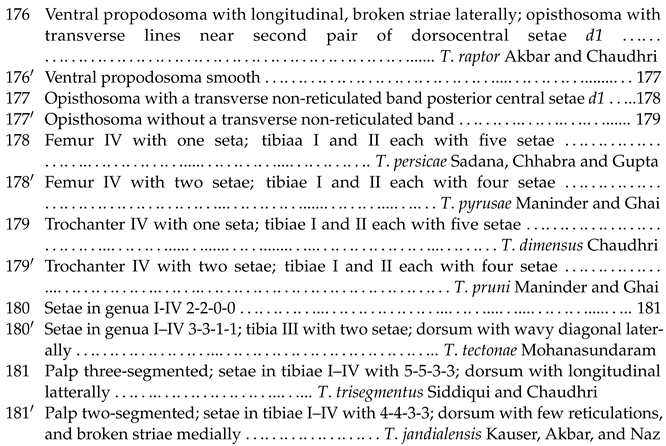
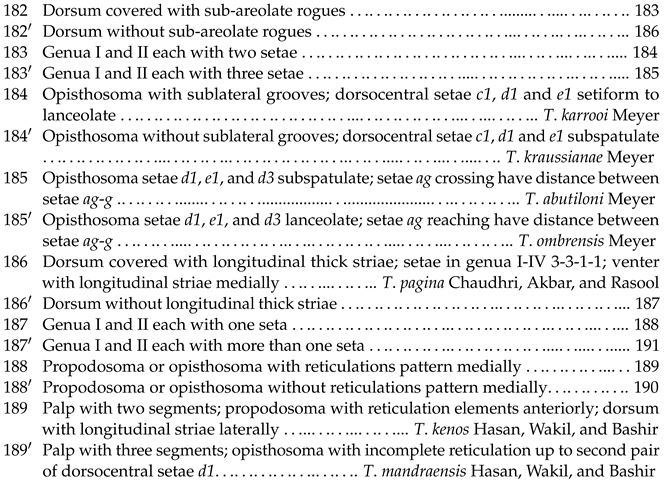

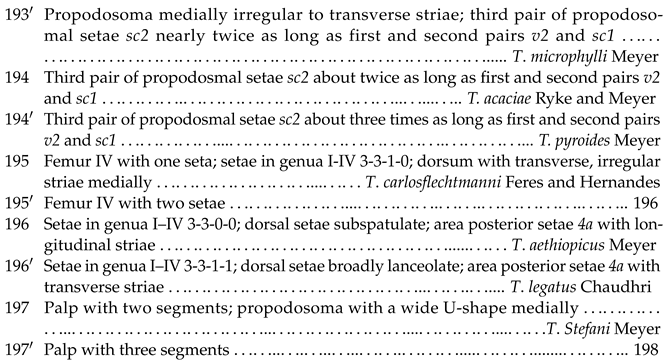
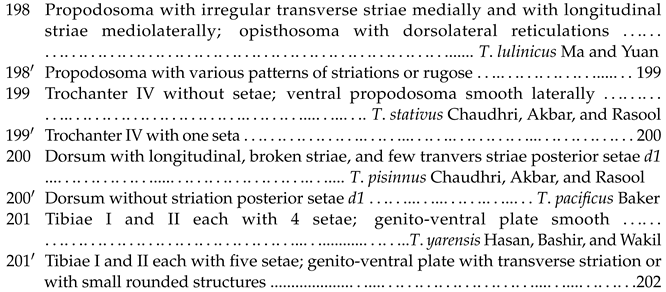
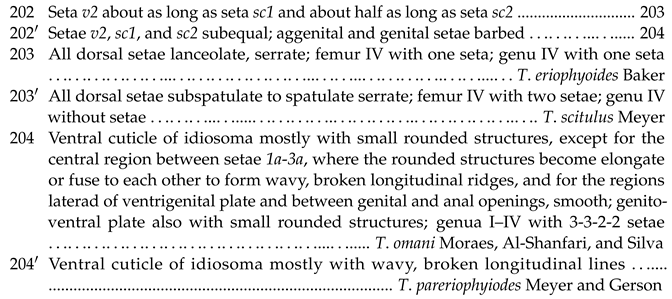
3.6. Key to the World Species of the T. dubinini Species Group (Based on Females)

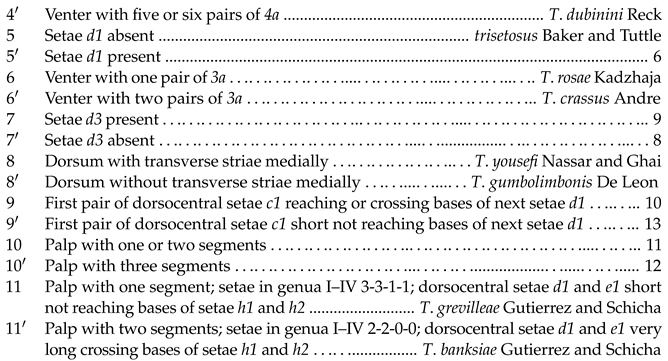
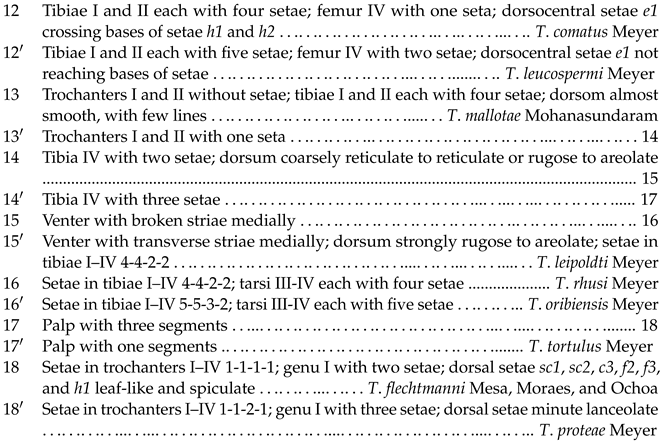
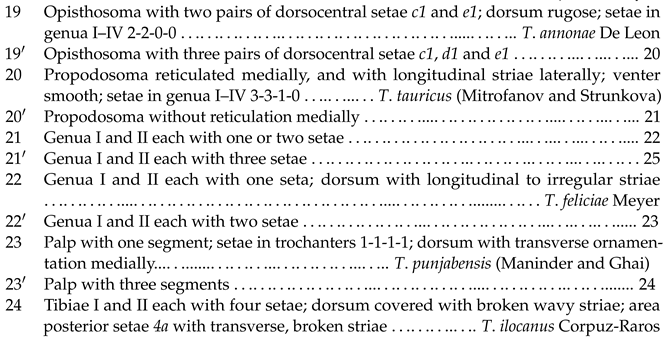
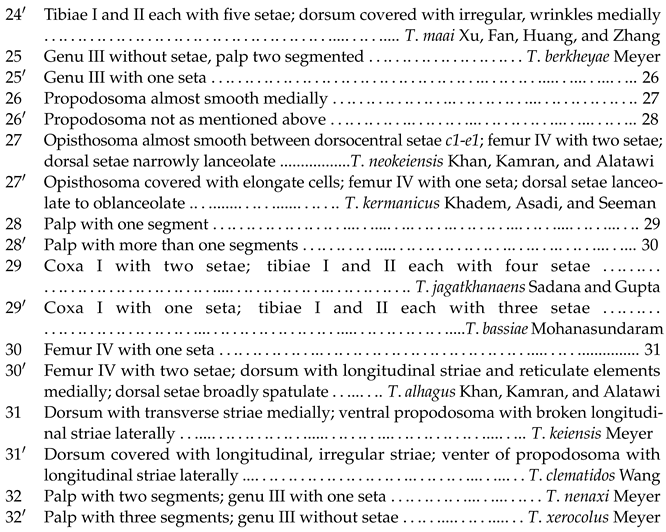
3.7. Key to the World Species of the T. granati Species Group (Based on Females)
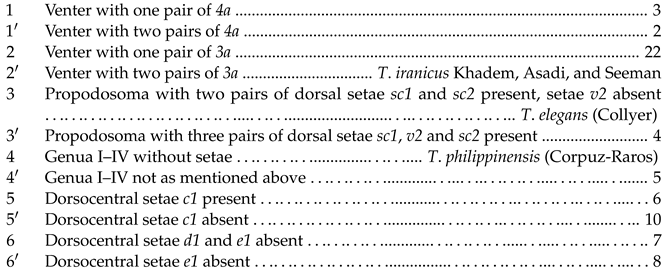
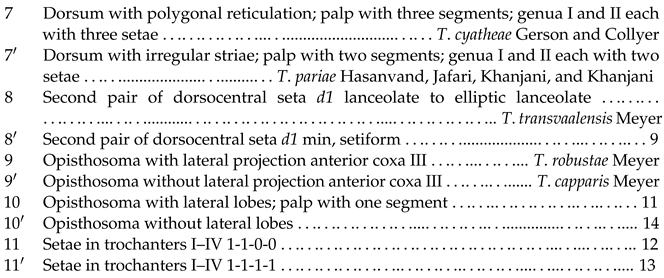

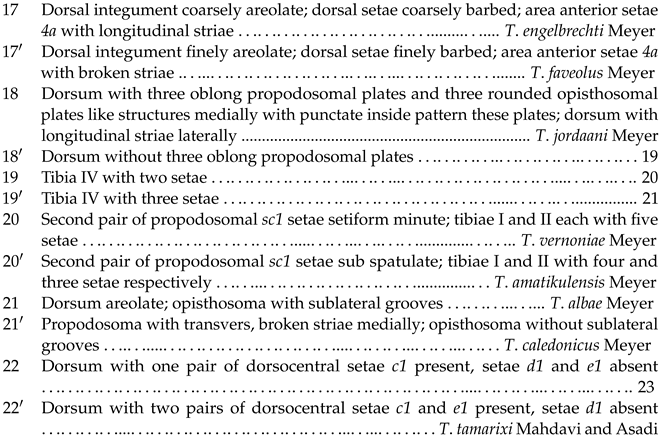
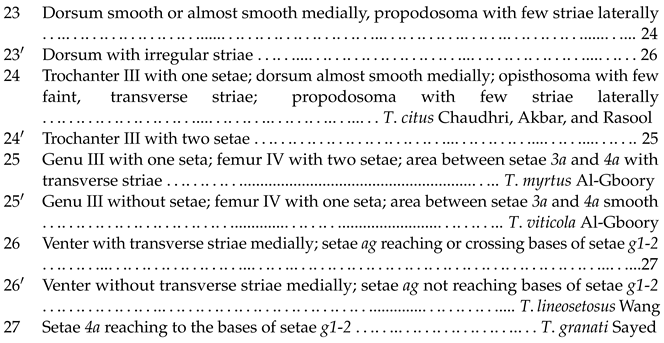

3.8. Key to the World Species of the T. barticanus Species Group (Based on Females)
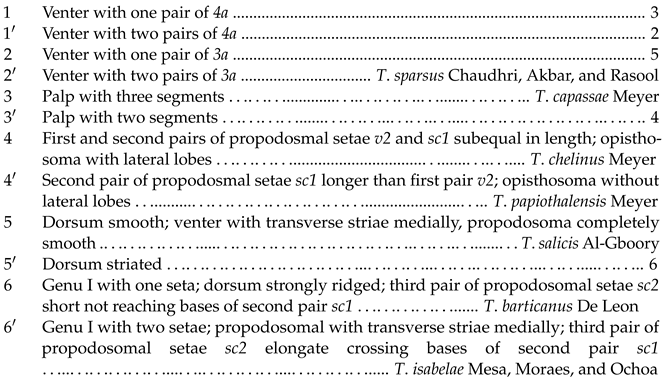
4. Discussion
The number of setae (dorsocentral and dorsolateral setae) has been used by different authors to erect tenuipalpid genera by transferring species from the genus Tenuipalpus, e.g., Aegyptopalpus Mitrofanov [7], Deleonipalpus Mirofanov [7], Gnathopalpus Mitrofanov [7], and Tuttlepalpus Mitrofanov [7]. Later, some of those genera were synonymized with the genus Tenuipalpus [8].
Different species groups were proposed based on the number of dorsocentral setae or dorsolateral setae [8,9,10]. According to the number of dorsolateral setae, two species groups, caudatus and proteae, based on the presence and absence of setae f2 (with seven and six pairs of dorsolateral setae), respectively. Later, these two species groups were divided into species subgroups based on the number intercoxal setae 3a and 4a were recognized [9,10]. Also, the character of dorsocentral and dorsolateral setae have been used as a first couplet in the different keys to classify the Tenuipalpus species (Al-Gboory [12]; Khanjani et al. [13]; Castro et al. [16]; Xu et al. [15]). The literature of 287 species of Tenuipalpus sensu lato signified the importance of dorsal opisthosomal setae as a prominent diagnostic morphological character. However, using the presence and absence of dorsolateral setae f2 (seven and six pairs of setae, respectively) could not be helpful, because some species (i.e., T. clematidos Wang, T. flechtmanni Mesa, Moraes, and Ochoa, T. isabelae Mesa, Moraes, and Ochoa, and T. salicis Al-Gboory) have six of dorsolateral setae (f2 present), but the dorsolateral setae (d3) is absent. Hence, those species can not be placed in any species groups that proposed Baker and Tuttle [9] and Meyer [10] because of these grouping caudatus and proteae is based on presence and absense of setae f2. However, some previous works are considering the number of dorsolateral setae to distinguish these two species groups, regardless of which dorsolateral seta is absent. For example, Mahdavi and Asadi [27] included two species (T. clematidos Wang and T. salicis Al-Gboory) in the proteae species group, which have setae f2 present. Therefore, we found that using the total number of opisthosomal setae is proper for dividing species groups, while the absence or presence of certain opisthosomal setae may be used for species differentiation in diagnostic keys. Hence, in this study, the four new species groups were proposed based on the number of opisthosomal setae.
4.1. Further Notes on the Poorly Described and Illustrated Species of the Species Group Carolinensis
The following remarks and additional notes are about those eight species belonging to the species group carolinensis, which were not included in the key due to poor/incomplete descriptions and illustrations. Their related species and a possible place in the diagnostic key are provided as follows:
Tenuipalpus chiococcae De Leon
The species T. chiococcae was originally described as close to T. pigrus Pritchard and Baker [17]. The recent classification by Castro et al. [1] placed T. pigrus in Tenuipalpus sensu stricto since this species bears a pair of lateral body projections associated with setae c3. The result of our study placed T. chiococcae among five species in the diagnostic key, i.e., T. aurantiacus Wang, T. angolensis Meyer, T. nigerianus Meyer, T. spatulatus Wang, and T. obvelatus Wan.
Tenuipalpus costarricensis Salas and Ochoa
Previously, T. costarricencis was considered close to T. granati Sayed [18]. However, in our study T. granati is placed in the group granati, while T. costarricensis came closer to three species; T. eucleae Meyer, T. garciniae Meyer and Bolland, and T. indicus Maninder and Ghai in the species group carolinensis.
Tenuipalpus ephedrae Livschitz and Mitrofanov
For the species T. ephedrae, the morphological characters were obtained from a poor redescription [19], and the original description was not found. The taxonomic information available in the redescription only helped to place this species in the group carolinensis.
Tenuipalpus molinai Evans
The species T. molinai was originally described as close to T. pedrus Manson [20]. The closely related T. pedrus Manson had been transferred to the genus Colopalpus Pritchard and Baker, previously [28]. However, the available morphological characters indicate that the species T. molinai belongs only to the species group carolinensis, but could not be assigned in the key.
Tenuipalpus oxalis Flechtmann
The species T. oxalis is poorly described and illustrated, and the related species was not provided [21]. The available morphological characters helped to designate the species only to the level of the species group carolinensis.
Tenuipalpus santae Manson
The species T. santae is morphologically close to T. celtidis Pritchard and Baker in the original description [22]. Tenuipalpus santae could not be placed due to missing leg cheatotaxy and other diagnostic characters.
Tenuipalpus simplychus Cromroy
The species T. simplychus was described as closely related to T. knorri Baker and Pritchard in the original description [23]. Due to missing leg chaetotaxy information, T. simplychus could not be assigned a certain place in the diagnostic key.
Tenuipalpus tetrazygiae De Leon
The species T. tetrazygiae, it was distinguished by the author from other described species of that time by the shape of dorsocentral setae and dorsum covered with irregular ridges [17]. Although this species has been placed in the caroliensis group, no certain place could be identified in the diagnostic key.
4.2. Synonymy of Some Species of the Carolinensis Species Group
The species T. lustrabilis was previously reported as a suspected junior synonym of T. punicae Pritchard and Baker [2,13]. We reviewed the original description and illustration [29] as well as the characters of T. lustrabilis in the published key by Meyer [8]. T. lustrabilis is hereby synonymized with T. punicae based on the number of shared characteristics, i.e., leg chaetotaxy, palp segmentation, shape and number of dorsal setae, pattern of dorsal reticulations, as well as its geographic distribution (Pakistan) and host plant (Punica granatum).
Similarly, the species T. guptai Sadana and Gupta was also suggested as a junior synonym of T. solanensis Sadana and Gupta [2,13]. We found that both species share most of their morphological features except for the number of setae on tarsi I-II (5-5 in T. guptai vs 7-7 in T. solanensis). This character has been commented to be a miscalculation [13], especially that T. guptai was described based on a single holotype female while T. solanensis only from three females. Moreover, both species were described based on specimens collected from the same host plant (P. granatum), the same type locality (India), on the same collection date (22-VI-1981), and have been mounted on the same slide (slide#91) [30].
Interestingly, the related species of T. solanesis is T. lustrabilis, which is declared as junior synonym of T. punicae. A detailed comparison of available description for both of these species show they are very similar; sharing leg chaetotaxy, palp segmentation, shape and number dorsal setae, pattern of dorsal reticulations, and host plant. Hence, the two species (T. guptai and T. solanensis) are also synonymized with T. punicae.
Tenuipalpus rodionovi Chalilova was described poorly without illustrations [31]. Therefore, it is neither assigned to any of the four species groups and not placed in the diagnostic keys. However, it was mentioned in the original description that it resembles three species: T. granati Sayed, T. zhizhilashviliac Reck, and T. kobachidzei Reck. The latter two species belong to the species group carolinensis, while the former one belongs to the granati new species group. Pritchard and Baker [32] and Wainstein [33] suspected this species as a junior synonym of T. granati. There is a need to check the type specimens of this species to validate its status. Hence, T. rodionovi is considered as a suggested synonym of T. granati until further studies are made.
5. Conclusions
The history of the genus Tenuipalpus is complicated due to taxonomic and classification-based modifications. This research indicates that the genus Tenuipalpus needs more taxonomical studies to raise the level of groups and species groups to higher taxonomical ranking, by using persistent and strong morphological characters. This may even direct future research in the family Tenuipalpidae to study the other closely related genera, in order to validate their status.
Author Contributions
Conceptualization, N.A.E. and M.K.; methodology, N.A.E. and M.K.; validation, M.K. and F.J.A.; formal analysis, N.A.E., F.J.A. and M.K.; investigation, N.A.E. and M.K.; data curation, N.A.E. and M.K.; writing—original draft preparation, N.A.E.; writing—review and editing, M.K. and F.J.A.; supervision, F.J.A.; funding acquisition, F.J.A. All authors have read and agreed to the published version of the manuscript.
Funding
The authors extend their sincere appreciation to the researchers supporting project number (RSPD2023R807), King Saud University, Riyadh, Saudi Arabia.
Institutional Review Board Statement
Not applicable.
Informed Consent Statement
Not applicable.
Data Availability Statement
All the relevant data has been provided here in the manuscript.
Acknowledgments
The authors wish to thank the researchers supporting project, at King Saud University, Riyadh, Saudi Arabia.
Conflicts of Interest
The authors declare no conflict of interest.
References
- Castro, E.B.; Kane, E.C.; Feres, R.J.; Ochoa, R.; Bauchan, G.R. Definition of Tenuipalpus sensu stricto (Acari, Tenuipalpidae), with redescription of Tenuipalpus caudatus (Dugès) and description of a new species from Costa Rica. Int. J Acarol. 2016, 42, 106–126. [Google Scholar] [CrossRef]
- Mesa, N.C.; Ochoa, R.; Welbourn, W.C.; Evans, G.A.; De Moraes, G.J. A catalog of the Tenuipalpidae (Acari) of the World with a key to genera. Zootaxa 2009, 2098, 1–85. [Google Scholar] [CrossRef]
- Castro, E.B.; Feres, R.J.; Mesa, N.C.; de Moraes, G.J. A new flat mite of the genus Tenuipalpus Donnadieu (Trombidiformes: Tenuipalpidae) from Brazil. Syst. Appl. Acarol. 2022, 27, 368–380. [Google Scholar] [CrossRef]
- Hoy, M.A. Agricultural Acarology: Introduction to Integrated Mite Management; CRC Press: Boca Raton, FL, USA, 2011; Volume 7. [Google Scholar]
- Donnadieu, A.L. Recherches pour Servir a l’Histoire des Tétranyques—Thèses; Faculté des Sciences de Lyon: Lyon, France, 1875; pp. 1–131. [Google Scholar]
- Reck, G. On the chaetological basis of the systematics of tetranychid mites. Soobshch. Akad. Nauk. Gruz. SSR 1959, 23, 465–471. [Google Scholar]
- Mitrofanov, V.I. Revision of the system of phytophagous mites of the subfamily Tenuipalpinae s. str. (Trombidiformes, Tenuipalpidae). Zool. Zhurnal 1973, 52, 1315–1320. [Google Scholar]
- Meyer, M.K.P. The Tenuipalpidae (Acari) of Africa. With Keys to the World Fauna; In Entomology Memoir; Department of Agricultural Technical Services: Johannesburg, South Africa, 1979; Volume 50, 135p. [Google Scholar]
- Baker, E.W.; Tuttle, D.M. The False Spider Mites of Mexico (Tenuipalpidae: Acari); Technical Bulletin Number 1706; United States Department of Agriculture—Agricultural Research Service: Washington, DC, USA, 1987; Volume 1706, 236p. [Google Scholar]
- Meyer, M.K.P. A revision of the genus Tenuipalpus Donnadieu (Acari: Tenuipalpidae) in the Afrotropical region. In Entomology Memoirs; Department of Agricultural Technical Services: Johannesburg, South Africa, 1993; Volume 88, 84p. [Google Scholar]
- Collyer, E. New species of the genus Tenuipalpus (Acari: Tenuipalpidae) from New Zealand, with a key to the world fauna. N. Z. J. Sci. 1973, 16, 915–955. [Google Scholar]
- Al-Gboory, I. Taxonomic Studies of False Spider Mites (Acari: Tenuipalpidae) in Central Iraq. Ph.D. Thesis, University of Bonn, Bonn, Germany, 1987. [Google Scholar]
- Khanjani, M.; Khanjani, M.; Seeman, O.D. The flat mites of the genus Tenuipalpus Donnadieu (Acari: Tenuipalpidae) from Iran. Int. J. Acarol. 2013, 39, 97–129. [Google Scholar] [CrossRef]
- Castro, E.B.; Feres, R.J. New species of Tenuipalpus (Acari: Tenuipalpidae) from Semidecidual Forest remnants in the State of São Paulo, Brazil. Zootaxa 2013, 3716, 475–493. [Google Scholar] [CrossRef]
- Xu, Y.; Fan, Q.H.; Huang, J.; Zhang, F.P. Two new species of Tenuipalpus and re-description of Tenuipalpus lineosetus Wang, 1983 (Acari: Tenuipalpidae) from China. Syst. App. Acarol. 2018, 23, 539–580. [Google Scholar] [CrossRef]
- Castro, E.B.; Feres, R.J.; Ochoa, R.; Bauchan, G.R. A new species of Tenuipalpus sensu stricto (Acari: Tenuipalpidae) from Brazil, with ontogeny and a key to the known species. Zootaxa 2016, 4088, 355–378. [Google Scholar] [CrossRef]
- De Leon, D. Six new false spider mites from southern Florida (Acarina: Tenuipalpidae). Fla. Entomol. 1956, 39, 55–60. [Google Scholar] [CrossRef]
- Salas, L.A.; Ochoa, R. Una especie nueva de ácaro plano Tenuipalpus costarricensis (Acari: Tenuipalpidae), en Costa Rica. Agron. Costarricense 1986, 10, 203–205. [Google Scholar]
- Livshitz, I.Z.; Mitrofanov, V.I. New species of mites (Tenuipalpidae, Acariformes). Zool. Zhurnal 1970, 49, 787–789. [Google Scholar]
- Evans, G.; Cromroy, H.L.; Ochoa, R. The Tenuipalpidae of Honduras (Tenuipalpidae: Acari). Fla. Entomol. 1993, 76, 126–155. [Google Scholar] [CrossRef]
- Flechtmann, C.H.W. Preliminary report on the false spider mites (Acari: Tenuipalpidae) from Brazil and Paraguay. Entomol. Soc. Wash. 1976, 78, 58–64. [Google Scholar]
- Manson, D.C. Seven new species of false spider mites (Tenuipalpidae: Acarina). Acarologia 1963, 5, 213–224. [Google Scholar]
- Cromroy, H.L. A preliminary survey of the plant mites of Puerto Rico. J. Agric. Univ. Puerto Rico 1958, 42, 74–87. [Google Scholar]
- Gupta, S.K.; Ghosh, S.K. Some prostigmatid mites (Acarina) from Andaman and Nicobar Islands. Rec. Zool. Surv. India 1980, 77, 189–213. [Google Scholar] [CrossRef]
- Berlese, A. Acarotheca Italica; Tipografia M. Ricci: Firenze, Italy, 1913; 221p. [Google Scholar]
- Duges, A. Recherches pour servir a l’ordre des Acariens en general et la famille des Trombidies en particulier. Ann. Sci. Nat. 1834, 1, 5–46. [Google Scholar]
- Mahdavi, S.M.; Asadi, M. New flat mite species of the genus Tenuipalpus (Acari: Tenuipalpidae) from Iran. Sysl. Appl. Acarol. 2018, 23, 2184–2191. [Google Scholar] [CrossRef]
- Castro, E.B.; Ochoa, R.; Feres, R.J.; Beard, J.J.; Bauchan, G.R. Reinstatement of the genus Colopalpus Pritchard and Baker (1958) and re-description of Colopalpus matthyssei Pritchard and Baker (1958), the type species of the genus (Acari, Tenuipalpidae). Int. J. Acarol. 2015, 41, 310–328. [Google Scholar] [CrossRef]
- Chaudhri, W.M.; Akbar, S.; Rasool, A. Taxonomic Studies of the Mites Belonging to the Families Tenuipalpidae, Tetranychidae, Tuckerellidae, Caligonellidae, Stigmaeidae and Phytoseiidae; Project No. A17-Ent-26; University of Agriculture: Lyallpur, Pakistan, 1974; 250p. [Google Scholar]
- Sadana, G.L.; Gupta, B.K. New species of the genus Tenuipalpus Donnadieu (Tenuipalpidae, Acarina) from India. Entomon 1984, 9, 141–147. [Google Scholar]
- Chalilova, S.G. Opisanie devuk novick tetranickovick kleschei ez semeist Bryobiidae I Trichadenidae. Soobshch. Akad. Nauk. Gruz. SSR 1953, 14, 549–551. [Google Scholar]
- Pritchard, A.E.; Baker, E.W. The false spider mites (Acarina: Tenuipalpidae). Uni. Calif. Publ. Entomol. 1958, 14, 175–274. [Google Scholar]
- Wainstein, B.A. Tetranychoid mites of Khazakhstan (with revision of the family). Trudy Naucno-Issledovatelskogo Instituta Zashiti Rastenij 1960, 5, 231–248. [Google Scholar]
Disclaimer/Publisher’s Note: The statements, opinions and data contained in all publications are solely those of the individual author(s) and contributor(s) and not of MDPI and/or the editor(s). MDPI and/or the editor(s) disclaim responsibility for any injury to people or property resulting from any ideas, methods, instructions or products referred to in the content. |
© 2023 by the authors. Licensee MDPI, Basel, Switzerland. This article is an open access article distributed under the terms and conditions of the Creative Commons Attribution (CC BY) license (https://creativecommons.org/licenses/by/4.0/).